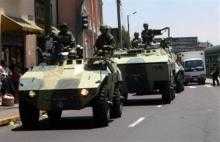Ecuador and Military Power
Many of us have seen or heard about the events on 30 September in Ecuador, a day where, quite simply, the world was turned on its head. Police officers burning tyres and throwing stones, taking over the hospital where the President had been allegedly “sequestered”.
What happened that day?
On the morning of September 30th, police officers and a few members of the military declared themselves on strike. They claim this was a response to a law approved by the National Assembly which cut a number of their social benefits and service awards usually received after a number of years in the force.
At this stage of the morning, the President decided to head over to the central police headquarters, in an attempt to bring calm and find a way out of the police and military protests. Once there, however, his words were received by protesters as a dressing down and further provocation, rather than a negotiation. At its height, the address took on melodramatic overtones, with the President pulling off his tie, ripping open his shirt and saying “If you intend to kill the president: do it. I am right here.”
The speech and its melodrama did little to appease the heated mood, adding rather, to the frustration among the police pickets. Soon, tear-gas bombs were shot into the building, which forced the president to take cover in the nearby police hospital.
From that moment on, the government’s rhetoric changed completely. Attempts to reach a consensus with the police force were dropped and the tone became openly confrontational. Immediately, uninterrupted governmental coverage of the situation was established in all media. Through this channel, the message that the President had been sequestered at the police hospital was repeated time and again. Furthermore, the broadcast openly called people to defend the “Citizens’ Revolution” by making their way to the hospital. Evidently, this brought about clashes between unarmed citizens and armed police forces who proceeded to attack the population.
That night, the government went on to organize a spectacular “rescue mission” to free the president from the police hospital. It did not matter, apparently, that inside there were newborn children and vulnerable elderly people: both sides – police and military forces – simply proceeded to open fire, until the President had been removed from the hospital, and approximately five people were killed.
Now, what lies behind these events? In my view, what happened was another example of the continuous growth of militarization and the control exerted by the Armed Forces over our countries. After all, those who ultimately decided to support the President and bring the conflict to an end were the military forces. As a result, only a few days later, a significant increase in salaries throughout military personnel was instated, placing them among the State employees with highest income and benefits in Ecuador. After September 30th, the lowest individual income for members of the military forces in Ecuador is US$780, in stark contrast with the average teacher, who earns roughly US$450.
The extent of the governments militarized apparatus was also evidenced, at least for the case of Ecuador. The array of repressive resources available to the police were also widely displayed during the day’s events. For example, it seems that more tear-gas bombs were fired in a single day than in the entirety of the year across the country. Furthermore, “security” forces’ weapons were used to attack the population at large: a warning, no doubt, as to the dangers of having armed groups financed by our own taxes.
Following these events, the country is left with mixed feelings: people have lost trust in the police forces, but have paradoxically gained confidence in the military, who now top the charts of credibility among national institution, according to polls.
Seizing this fair wind, the government has begun a “which hunt” of sorts, targeting not only police officers, but also a series of members of civil society. A number of people have been accused of masterminding September 30th, and the president has even announced an investigation into NGOs and activist groups considered suspects in the day’s events.
In other words, this violent episode became an opportunity for consolidating a State with a larger repressive apparatus, and greater control over the population. Even now, laws are being passed which allow telephone tapping and inquiries into the finances of uninformed individuals. In the light of this new state of affairs, a reflection is called for: the fateful events of a single day such as this, can be feed the rise of a more militarized and controlled society, as we have seen for the USA after September 11th.
It seems that contemporary governments are attempting to exact gains from calamitous days such as these, to be able to consolidate more vertical power structures, effecting greater control over society at large. It becomes necessary, therefore, for those of us involved in peace movements and anti-militarism, to take this into account, so as to generate strategies in our causes, and effectively block the advances of militarism in our countries and regions.
Today, more than ever, we must come up with new strategies to counteract the new forms of militarism that are, bit by bit, being imposed upon our countries.
Xavier León
(Conscientious Objection Group of Ecuador - GOCE)
Translation by Benjamin Molineaux
More information on September 30th at:

Add new comment